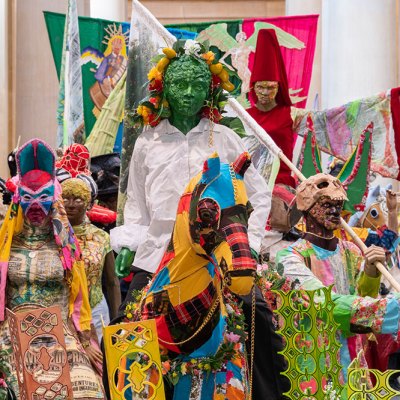Until a few weeks ago, there wasn’t much of a contemporary art scene in Malta. The collection of the country’s largest gallery, the National Community Art Museum (MUŻA), does not extend past the early 21st century; there is little more than a smattering of commercial galleries in the capital, Valletta; and only in 2017 did Malta begin exhibiting regularly at the Venice Biennale (its previous appearances had been fitful).
The grand opening of the Malta International Contemporary Arts Space (MICAS) on 25 October – complete with fireworks, dramatic music, the live-streamed unveiling of a plaque and an address from the Prime Minister – heralded an attempt to address this situation. For MICAS’s artistic director Edith Devaney, the country’s first ever national contemporary arts museum – as MICAS bills itself – is something new for the Maltese public, who have ‘never experienced anything quite like this’. For now a non-collecting museum, though Devaney suggests that this might be revised in future, MICAS is akin to ‘the Serpentine Gallery or the New Museum, which don’t have collections’; instead of needing to ‘mould a programme in support of the works we’ve got’, she says, the museum is able to craft an interconnected programme of touring exhibitions and related events.
As for its broader goals, the project – which had a price tag of €30 million, funded by the Maltese state and the European Regional Development Fund – has both a local and international focus. Prime minister Robert Abela has lauded MICAS for making Malta ‘a centre for artistic creativity in the Mediterranean, and a natural home for artists’, and Phyllis Muscat, chair of MICAS, believes that the museum will turn Malta into ‘a proactive player in the contemporary art world’. Meanwhile, as Devaney emphasises, it has to ‘appeal to the public here’ and ‘be sensitive to their needs and likes’.

A desire to bring in the Maltese people – including those who wouldn’t necessarily count themselves part of the local ‘art crowd’ or the great and the good present at the opening – is evident in Devaney’s choice of Joana Vasconcelos as the artist tasked with creating the museum’s opening show, ‘Transcending the Domestic’. The Portuguese artist’s signature large-scale installations take over the 1,400 sqm of gallery space, infusing the renovated 17th-century fortifications on the edge of Valletta with a palpable sense of fun.
Entering the light-filled building, which combines the excavated walls with a roof of float glass and steel beams, visitors are greeted by the suspended installation Valkyrie Mumbet (2020). This colossal inflatable structure, which visitors must walk under to appreciate its intricacies, is exuberant and inviting, while its marriage of brightly coloured African printed textiles and Portuguese lace and crochet speaks to a darker historical reality, namely Portugal’s role in the transatlantic slave trade. (The installation’s title refers to the enslaved woman Elizabeth ‘Mumbet’ Freeman, who successfully sued for freedom in a 1781 court battle that helped make slavery illegal in Massachusetts.)
Vasconcelos’s construction of Valkyrie Mumbet out of textiles, a medium traditionally associated with women’s ‘craft’ rather than fine art, offers a fitting introduction to a wider theme of the exhibition: using materials – or consumer products – and techniques associated with domesticity to connect with weighty questions of spirituality, gender, colonialism and climate.

To explore the terraced layout of the building, visitors must amble over the roots of the towering Tree of Life (2023), with its 110,000 hand-stitched fabric leaves; by bringing out the connection between earth and sky, it also bridges the ordinary and the spiritual. We wander through the enchanting Garden of Eden (2007–24), made up of illuminated artificial flowers that Vasconcelos says are ‘found in Chinese restaurants all over the world’ and which hint at the disappearance of nature amid climate change, before encountering the artist’s more overt, often playful subversions of domesticity. These include Euro-vision (2005), a television showing the 1982 Eurovision Song Contest – when Portugal was represented by Doce, one of Europe’s first girl bands – decorated and obstructed by a crochet cover.
Visitors are encouraged to get up close to the works – to feel the diverse textures created by the different techniques used to adorn Valkyrie Mumbet and each of the individual Tree of Life leaves. Certain works require activation by viewers: Spin (2001), for example, features a collection of blow-dryers arranged around a circular mirror, akin to the petals of a flower. Stepping onto the platform in front of the mirror, the viewer activates the hairdryers, looking back at the reflection of their own windswept hair.
MICAS’s opening ceremony was preceded by a calendar of public talks, an online exhibition and a free public show of sculptures by Conrad Shawcross. It will be followed in May 2025 by an exhibition of leading Malta-based contemporary artists, which will make way for an exploration of Milton Avery’s influence on contemporary art and a solo exhibition by Reggie Burrows Hodges. Publicising this diverse roster so early was intentional, Devaney says: ‘It was important that we announce the programme a couple of years in advance, so we’re not defined by our first exhibition.’

The road to the opening has not been without obstacles and controversies. In addition to the opening being pushed back from 2021 by project delays, MICAS faced accusations of misuse of public funds and conflicts of interest over the museum’s commissioning in 2019 of a €500,000 statue by Swiss sculptor Ugo Rondinone, who allegedly had close commercial connections with a MICAS board member.
With corruption scandals plaguing the highest levels of Malta’s previous government, including former prime minister Joseph Muscat being charged with money laundering, fraud, conspiracy, bribery and corruption in May, current culture minister Owen Bonnici is keen to set his government apart and vehemently denies any conflicts of interest. ‘MICAS takes good governance very seriously. As laid down in MICAS’s publicly available acquisitions policy, MICAS only acquires works by artists who have established a critical international reputation,’ Bonnici said when I asked him about the accusations. He underlined that MICAS has oversight from the National Audit Office and MPs. ‘Due diligence is carried out to ensure the artwork, or the process of making and installing it, does not contravene any Malta-adopted regulations,’ he added.
MICAS finds itself even more closely watched following Malta’s first ever Biennale this spring, which was criticised by the Malta Entertainment Industry and Arts Association for a lack of transparency and professionalism. This group, Bonnici was keen to point out, lauded MICAS as a ‘remarkable establishment [that] will play a vital role in Malta’s cultural landscape.’

As I watch the throngs of invited guests stream in and out of the space, enjoying an opera performance amid Vasconcelos’s exhibition before sipping on a strawberry margarita at the bar, I wonder if this excitement will be sustained once the party is over – and will translate into encouraging visitor numbers, particularly among the local community.
‘I don’t know what their expectations are […] right now we just don’t know: how are they going to use and respond to it?’ Devaney ponders. ‘[But] they’re the ones that are going to give it life.’
‘Joana Vasconcelos: Transcending the Domestic’ is at MICAS, Floriana, until 27 March 2025.


